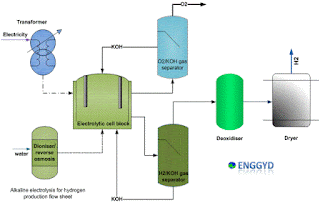Hydrogen is a key fuel that is turning the view of energy consumption towards clean fuels which do not harm the environment and do not release harmful gases to the atmosphere as it produces water and an enormous amount of energy during combustion than any of the fuel. It increases the economy and efficiency of the machines but availability and production technologies are not yet effectively published, vigorous research work is going on to make cheaper, safer production of hydrogen but it all depends on the source and raw material required from which hydrogen can be produced.
Well, let’s say the idea of fossil fuel contains a high concentration of hydrogen but it makes a circle to the starting step of pollution, so the only raw material which is abundant is water this can be used to produce hydrogen but why this is not used for the production of hydrogen, split hydrogen mean again it requires energy.
Hydrogen production techniques:
1. By a method of silicon chip-based microreactor by methanol-reforming.
2. Water splitting by solar energy using a thermochemical cycle or water electrolysis
3. Photoelectrolysis
4. Reforming of natural gas
5. Gasification of coal and biomass
6. The photo-biological method with the high-temperature decompositions.
7. Hydrocarbon reforming
8. Ammonia cracking
9. Pyrolysis
10. Aqueous reforming
11. High-temperature electrolysis
12. Photo-electrolysis (photolysis)
13. Photo-biological production (biophotolysis)
All the above technologies depend on the raw material used for the production of hydrogen, the mostly known feedstocks and process dependents are Algae, Gas, Oil, Wood, Coal, biomass, and Power.
a) Hydrogen from NG
We have three chemical production processes
1. Steam reforming
CH + H O + heat → CO + 3H
CO + H2O → CO2 + H2 + heat
2. Partial oxidation
CH4 + 1 / 2O2 → CO + 2H2 + heat
3. Auto thermal reforming of the above two methods is used simultaneously.
b) Hydrogen from Coal
By coal gasification in a fixed bed or fluidized bed gasifier hydrogen can be produced
C(s) + H2O + heat → CO + H2
c) Hydrogen production from water by splitting
H2O + electricity → H2 + 1 / 2O
d) Alkaline electrolysis cell

Electrolyte: 4H2O ↔ 4H+ + 4OH–
Cathode: 4 H+ + 4e–↔2H2
Anode: 4OH– ↔ O2 + 2H2O + 4e–
Sum: 2H2O ↔ O2 + 2H2
e) Polymer electrolyte membrane (PEM) electrolysis
Anode: H2O→ 1 / 2O2 + 2 H+ + 2e–
Cathode: 2H+ + 2e–→ H2
Photosynthesis: 2H2O → 4H+ + 4e– + O2
Hydrogen Production: 4H+ + 4e–→ 2H2
f) High-temperature decomposition
Thermo-chemical water splitting
(850 °C): H2SO4 ↔ SO2 + H2O + 1 / 2
120 °C): I2 + SO2 + 2H2O → H2SO4 +
(450 °C): 2HI → I2 + H2
SUM: H2O → H2 + 1 / 2O2
Hydrogen storage in solid form
- Using microporous metal-organic materials
- Carbon nanotubes and graphite nanofibers
- Platinum and palladium nonporous films
- Using boron nitride nanotubes
Hydrogen storage in liquid form:
- Composite tanks
- Glass microspheres
- Cryogenic liquid hydrogen (LH2)
- NaBH4 solutions:NaBH4 (l) + 2H2O (l) → 4H2 (g) + NaBO2 (s) (ideal reaction)
- Rechargeable organic liquids
Related Essay
- PH Measuring Instruments, Working Principle, Theory, And Determinating Methods
- Naphtha Reformer For Hydrogen Production | Natural Gas Plant Design And Process Description
- MULTI-COMPONENT DISTILLATION COLUMN DIAGRAM | Nanobots And Nanotechnology
- Spark Plug Maintenance And Function In Performance Of Automobiles | Motorcycle Maintenance Workshops And Services
- Production Process Options For High-Impact Polystyrene
- Types And Modes Of Heat Effects | Individual Heat Transfer Coefficient And Thermal Diffusivity Calculator
- Flow Through Packed And Fluidized Beds | Fluid Mechanics
- Fluid Catalytic Cracking Unit Flow Sheet And Process Equipment





